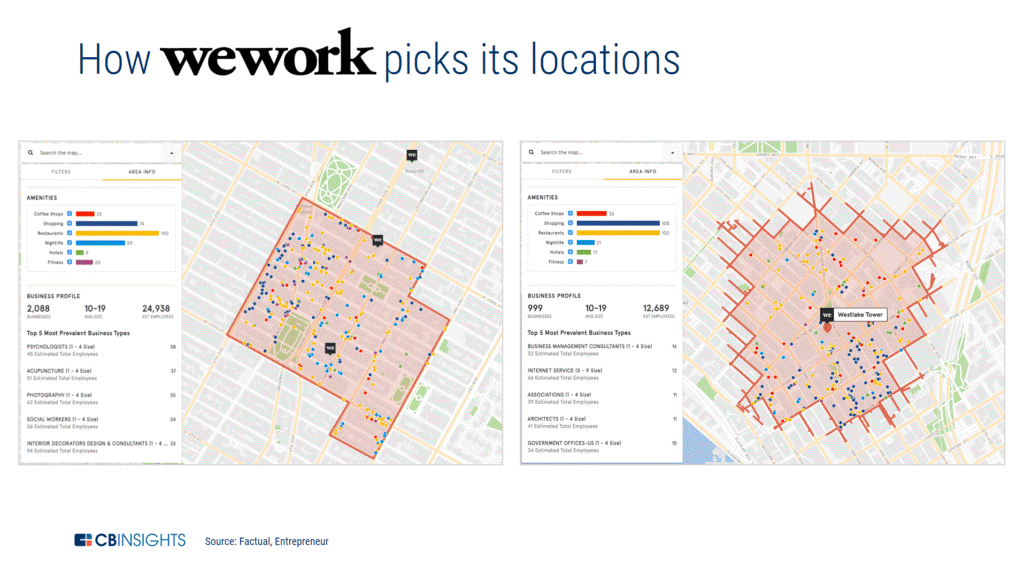WeWork: Machine Learning meets Real Estate

Machine Learning + Real Estate = An Optimal Workplace Solution.
Exponential Growth at WeWork
After my first week at WeWork, I remember asking myself countless questions about how management was operating the business amidst an ambitious growth target of doubling its members (aka customers) to 400,000 by the end of 2018 [1]. How were they selecting cities for future locations, how were they designing those buildings to meet the demands of future members (aka customers), and how were they able to do all of this with speed and precision. Over time, I realized that machine learning was the central element that answered these and other questions and it has contributed to the company’s exponential growth. [1]

Machine Learning, Process, and Product Innovation at WeWork
Machine learning is so important at WeWork because it drives the company’s value proposition and differentiates its offering from competitors’. WeWork prides itself on its ability to deliver optimal real estate solutions for its members, no matter the size of a member’s organization. However, anyone that is familiar with the competitive landscape knows that there are a variety of companies that offer these same services (Regus, Knotel, regular lease, etc). However, what makes WeWork different is how the company incorporates machine learning techniques into its business model to develop these solutions for its members. For example, the company utilizes a very thorough, data-driven approach to “address the bottleneck in location vetting” for its new markets [2]. WeWork will rate locations based on proximity to amenities and businesses, then pass this data off to real estate teams that will have the final say on where these new buildings will be established. [3] and [4]

WeWork is also using machine learning to create innovative products for its enterprise clients. One product, known as Powered by We, is a custom real estate solution where clients partner with WeWork to create the optimal workspace. WeWork kicks off all Powered by We partnerships by using machine learning techniques to carefully analyze a client’s current office building to understand how employees are utilizing the space. Over time, this information is aggregated and then incorporated into the design of the new building in order to maximize its space efficiency. [6] and [7]
Next Steps for Machine Learning at WeWork
Moving forward, I think there is room for WeWork to gain further insights from machine learning. One recommendation that I have is to leverage the concept to improve internal processes in addition to its external ones. When I worked at the company, I spent a few weeks in sales and noticed the robust systems in place to help salespeople prospect new clients. However, there could be an opportunity to use machine learning to help predict which clients are “most successful” during the prospecting process which would allow the sales teams to have a much more targeted, effective approach. Another recommendation that I have is to extend machine learning across the company’s other lines of business such as WeGrow, WeLive, and Rise by We. These are WeWork’s school, housing, and gym concepts and are all great platforms for future innovation. For example, the company might use machine learning techniques to predict the ideal location for its gyms, based on feedback from current members or use machine learning to assess performance potential of its students.
As I think about the future of WeWork and machine learning, I still have a few outstanding questions. First, as the company looks towards an inevitable IPO, how will it prove the value of machine learning to future investors? Second, will the company use machine learning across its people management processes as well?
(Word Count: 770)
Sources
[1] J. Wilson, S. Sachdev, and A. Alter. How companies are using machine learning to get faster and more efficient. Harvard Business Review Digital Articles (May 3, 2016).
[2] [WeWork report], via CB Insights, https://www.cbinsights.com/research/report/wework-strategy-teardown/#data, accessed November 2018
[3] Trefis Team, “Can WeWork Sustain its High Growth – The Key To Its Lofty Valuation”, Forbes, June 6, 2018, https://www.forbes.com/sites/greatspeculations/2018/06/06/can-wework-sustain-its-high-growth-the-key-to-its-lofty-valuation/#b1bedac70e69, accessed November 2018.
[4] Lydia Belanger, “Here’s How WeWork Pinpoints the Perfect Locations for Its Co-Working Spaces in Neighborhoods”, Entrepreneur.com, September 25, 2017, https://www.entrepreneur.com/article/300677, accessed November 2018.
[5] Nicole Phelan, “Designing with Machine Learning”, WeWork Blog, November 9, 2016, https://www.wework.com/blog/posts/designing-with-machine-learning, accessed November 2018.
[6] WeWork, “Powered by We”, https://www.poweredbywe.com/how-it-works, accessed November 2018.
[7] Jessi Hempel, “Why WeWork Thinks It’s Worth $20 Billion”, Wired.com, September 06, 2017, https://www.wired.com/story/this-is-why-wework-thinks-its-worth-20-billion/, accessed November 2018.



Wow, really interesting seeing what’s behind WeWork’s growing business. I 100% agree that WeWork is firstly and lastly a real estate company. My struggle is still with how its real estate business compares to other real estate business, chain restaurants for example. I know a number of companies are using machine learning to assist in real estate decisions, is WeWork much better here? Moreover, I agree that as a real estate company that seems to have found success, they should move beyond shared office space and use their ‘secret sauce’ in other areas such as gyms and schools. But is there a possibility of licensing? Why go through the trouble of operating gyms, hospitals, and schools? Would someone pay for Wework to pick real estate locations on their behalf?
I’m amazed by how WeWork uses data from layout of current locations and utilization of rooms to predict future usages and improvements. I agree that
extending to its school, housing, and gym platforms are the appropriate next moves. In addition, I wonder if they can try out the realtor space, analyzing home buyers preference and better match them with properties than Redfin and Zillow? Recently went through this process myself, I believe there is definitely room for machine learning in property searching to filter and optimize location, lifestyle/neighborhood, room type/functions, odd things to watch out in their documents etc.